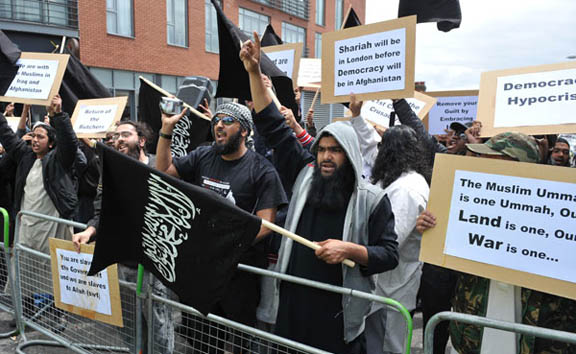Britain: Hundreds of Potential Suicide Bombers Bide Their Time
10/10/2011
In the United Kingdom, security experts conservatively estimate that 200 Islamic suicide bombers residing in the country are ready to go. Police are considering the opportunities for mayhem afforded by the Olympic games taking place in London next summer. At the same time, Muslim jihadists could strike on any ordinary day, as four did July 7, 2005, when they set off bombs on their bodies and killed 52 Londoners on public transportation.
Britain’s constant level of deadly threat from Muslim immigrants should be a reminder to America of the insanity of welcoming potential enemies by the thousands every year, as diversity-crazed Washington continues to do. In fact, Muslim immigration is on track to increase in America. Could anything be more unwise from a national security perspective? If Muslim immigration is allowed to continue, we can expect to see similar behavior here. The only difference between the US and Britain is the number of Muslim immigrants, and we are catching up to the European level of foolishness.
Below, hostile Muslims residing in Britain demonstrated against returning troops in 2010.

200 suicide bombers ‘planning attacks in UK’, London Telegraph, October 8, 2011
At least 200 potential terrorists are actively planning suicide attacks while living freely in Britain, intelligence chiefs have warned ministers.
A senior intelligence source has revealed that the figure is a “conservative” estimate of the threat facing the country from UK-based Islamist suicide bombers.
The would-be killers are among 2,000 extremists who the security services have said are based in Britain and actively planning terrorist activity of some kind.
The figures are contained within a secret government report on the “enduring terrorist threat” facing the UK from al-Qaeda and affiliated organisations, The Sunday Telegraph has been told.
While the deaths of Osama bin Laden and Anwar al-Awlaki may have left al-Qaeda without a charismatic leader, both the Secret Intelligence Service, MI6, and the Security Service, MI5, believe the organisation remains as dangerous as ever.
The warning comes as Britain begins preparations for next year’s 2012 Olympic Games, which has been described by MI5 as the biggest security operation in the country’s history.
But senior sources believe that rather than targeting Olympic venues, where security will be extremely high, terrorists will be tempted to attack areas where crowds are likely to congregate such as train stations and public events.
If terrorists were to mount an attack in Britain of the kind seen in other countries, by packing a single explosive vest with hundreds of ball bearings then detonating it in a crowded enclosed area such as a station terminus at rush hour, they could kill up to 120 people according to one explosives expert.
The 200 British residents thought to be planning suicide attacks, either within the UK or overseas, represent one in 10 of the wider group of 2,000 terrorist plotters.
The intelligence source added that suicide bombers would only be stopped by either a “chance encounter” or by an intelligence-led investigation. But he added that if a terrorist cell was properly organised and secure there was very little the authorities could do to prevent an attack.
The latest disclosure follows the arrest of six men from Birmingham who were remanded in custody two weeks ago over an alleged UK suicide bombing plot.
Two of the six, Irfan Nasser and Irfan Khalid, are accused of preparing for an act of terrorism, including travelling to Pakistan for training in terrorism, making a martyrdom video and planning a bombing campaign. They are also accused of “being concerned in constructing” a home-made explosive device for terrorist acts and stating an intention to be a suicide bomber.
Earlier this year, classified intelligence documents disclosed by the whistle-blowing website WikiLeaks, showed that MI6 officers believed that Britain was facing a wave of suicide attacks from British-based Muslim extremists who had been trained in terrorist camps in Pakistan.
One report quoted an MI6 officer’s briefing to US officials in which he said: “The internal threat is growing more dangerous because some extremists are conducting non-lethal training without ever leaving the country. Should these extremists then decide to become suicide operatives, HMG [Her Majesty’s Government] intelligence resources, eavesdropping and surveillance would be hard pressed to find them on any ‘radar screen’.”
One intelligence official told this newspaper: “We may have only had one ’successful’ suicide attack in Britain but the tactic remains an enduring threat. This is a generational problem we are facing. The terrorists are learning all the time and adapting their tactics. They now operate a cell structure and there security is very tight.
“Suicide bombers know the signs we will be looking for. So they don’t pray in the moments before an attack, there will be no heavy coats in summer and they are becoming much more security aware. For every countermeasure we develop they create a new ‘measure’. They will always be looking for our exposed flank.”
Intelligence experts believe that suicide bombers are motivated by a number of factors including politics, religion, poverty, finance and social factors.
Research has shown that they can be drawn from all social strata and can range from the well-educated to the mentally impaired. In Iraq and Afghanistan, young children and women have been recruited, while in London, the 7/7 bombers who killed 52 people and injured hundreds more in four coordinated attacks on the Tube and bus network came from stable backgrounds with close families.
Another classified report, details of which have been passed to this newspaper, stated that suicide attacks had developed as the weapon of choice for al-Qaeda and its supporters because of the level of fear that such attacks can engender.
The report cited examples of past suicide attacks which were perceived by the organisations which mounted them as having produced successful outcomes, such as the Beirut barracks bombing of 1983 which was followed by the withdrawal of US forces from Lebanon.
